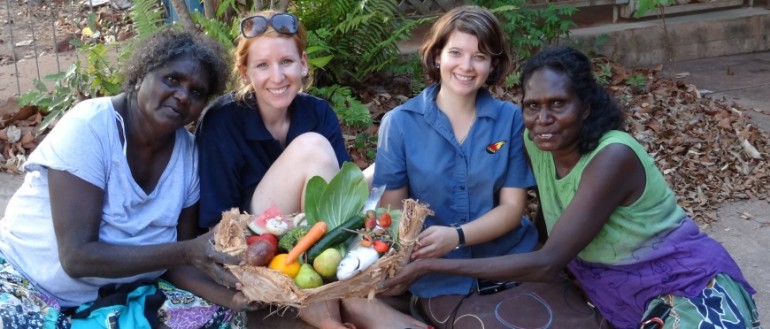How balloons are improving baby brain development
Bonnie Moss is seated with her legs crossed in the dirt in a small circle of Indigenous mothers in a remote Aboriginal community in Central Australia, Northern Territory.
She’s holding three rice filled balloons, the smallest the size of a tiny new born baby’s brain and the largest the weight and size of an adult. As she passes the balloons around the group, she encourages the ladies to suggest the age of the middle size balloon – 11, 15 or maybe 20 years is their answer. It’s a baby’s brain, aged three. There are usually sudden bursts of laughter as members of the group are taken by surprise. They are engrossed.
As a Child Development Health Researcher, Bonnie explains this activity demonstrates in a tactile and hands on way how brains rapidly develop before birth and in a child’s very early years.
“During the last 20 years there has been an explosion in what scientists understand about child development, especially knowledge about early brain (neural) development,” she said.
“We know more about why the early years to the age of three are the most important for brain development. The brain is very sensitive at this time so knowing the things we can do is important.”
“Most of the brains connections are laid down very early in life and these are crucial for effective learning. Support and stimulation from adults builds babies brains – this is as important as good nutrition. “
This activity and the DVD that accompanies it has messages for the whole community about the importance of a healthy start and nurturing relationships for building babies brains.
Researchers with Menzies’ Centre for Child Development and Education have developed the ‘brain story’ activity and a DVD to engage parents and early years professional in a shared story about early development and how a good start is important for communities as a whole.
“These props are instrumental in transforming information from abstract theory into important knowledge sharing opportunities in our community,” Ms Moss said.
Bonnie explains that early experiences are built into our bodies, creating biological “memories” that shape development for better or for worse. Young children are programmed to adapt to whatever environment they are born into, so we need to make sure these are safe, nurturing and meet the child’s needs as much as possible.
“This ‘brain story’ is a story we share about the importance of early brain development to set solid foundations to put children on a strong pathway for life,” she said.
Getting the foundations right in out early years is much more effective, and less costly to individuals and society, than trying to fix things later on.
“We believe that the whole community needs to understand and be involved is supporting parents and getting children the best start in life”.
Bonnie, with former Menzies staff member, Anne Hanning, have developed a workshop around the brain story to use with parents, community members and early childhood workers while sharing results of the first National Australian Early Development Index on 2011.
The brain story provides activities to open dialogue about getting all children the best start in life in addition to discussing what parents and communities can do to build brains.
“These workshop do not require literacy skills, it is about sharing knowledge in a relaxed conversation. The activities have been used many times, and information about them can be accessed through Menzies’ Centre for Child Development and Education,” Ms Moss said.
An excerpt from the ‘brain story’
The brain is the control centre of the body. It looks after our movements, our feelings and our thoughts. In the same way as a telephone operator directs calls, your brain directs messages all around your body.
All our brain cells are formed before we are born. However, these cells need to connect in the right way to enable our brains to work properly. The connections that we use most become strong, while those that are not used much can be lost completely.
Scientists have found that the brain makes most of its connections before the age of three, so these early years are critical for brain development. Each time you learn something new, you make new brain connections. Your brain takes a long time, up to 24 years to be built.
The growing brain is vulnerable to infections like measles, and to the toxins found in alcohol and tobacco. It is also at risk from accidents and stress. That’s why a baby that is secure, healthy, and well-cared for will learn much more easily.
Scientists have found that the early years to the age of three are the most important for brain development.

